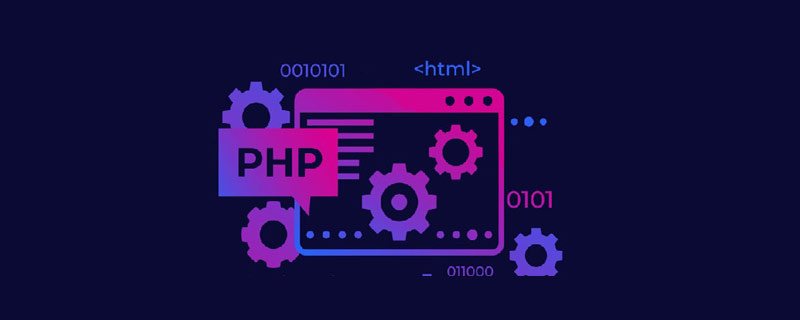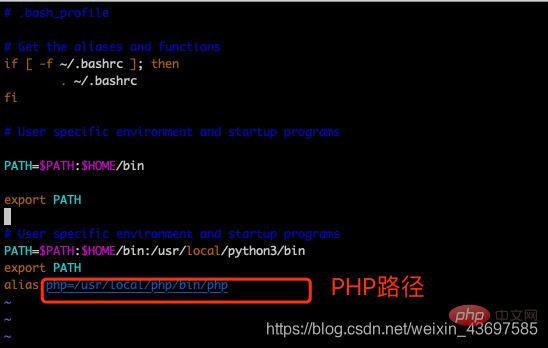How to install php on centos 7.5
How to install php on centos7.5: 1. Add php user for running php-fpm process; 2. Unzip the php source code package; 3. Install dependency packages; 4. Copy relevant configuration files to php installation Path is enough.

The operating environment of this article: CentOS7.5 system, php7.4.1 version, DELL G3 computer
How to install php on centos 7.5?
CentOS-7.5 Compile and install php-7.4.1
##Travel record: Generally, yum is used to install the package, which is more resistant to source code compilation. After searching on Baidu, it was successfully installed~1. Environment preparationVirtual machine: centos 7Download the source file php-7.4.1:
wget https://www.php.net/distributions/php-7.4.1.tar.gz (Due to half of the download error on the server , change to local download and upload to server scp php-7.4.1.tar.gz root@server ip:/usr/local/)
- Add php user, used to run the php-fpm process
-
cd /usr/local/ useradd php -s /sbin/nologin
Copy after login

- Unzip the php source package
-
tar -zxf php-7.4.1 .tar.gz Install dependency packages
Install dependency packages -
yum install libxml2-devel sqlite-devel libcurl-devel oniguruma-devel libpng-devel libjpeg-devel freetype-devel libzip-devel openssl-devel -y
Copy after logincd /usr/local/php-7.4.1
Copy after login
- Compilation parameter reference
-
[root@iZ8vbice4h2bcujon9zc00Z php-7.4.1]# ./configure --prefix=/usr/local/php --with-config-file-path=/usr/local/php/etc --with-mhash --with-openssl --with-mysqli=mysqlnd --with-pdo-mysql=mysqlnd --with-iconv --with-zlib --enable-inline-optimization --disable-debug --disable-rpath --enable-shared --enable-bcmath --enable-shmop --enable-sysvsem --enable-gd --with-jpeg --with-freetype --enable-mbregex --enable-mbstring --enable-ftp --enable-pcntl --enable-sockets --enable-soap --without-pear --with-gettext --enable-session --with-curl --enable-opcache --enable-fpm --with-fpm-user=php --with-fpm-group=php --without-gdbm --enable-fast-install --disable-fileinfo
Copy after login[root@iZ8vbice4h2bcujon9zc00Z php-7.4.1]# make && make install
Copy after login
 Compilation and installation completed
Compilation and installation completed
Start the script: php-7.4.1/sapi/fpm/init. d.php-fpm
cd /usr/local/php-7.4.1/sapi/fpm/ cp init.d.php-fpm /usr/local/php/
php.ini configuration file: php-7.4.8/php.ini-production
cd /usr/local/php-7.4.1 cp php.ini-production /usr/local/php/etc/php.ini
Create php -fpm.conf configuration file
Enter the etc/usr/local/php/etc
[root@iZ8vbice4h2bcujon9zc00Z etc]# pwd /usr/local/php/etc [root@iZ8vbice4h2bcujon9zc00Z etc]# ls php-fpm.conf.default php-fpm.d php.ini [root@iZ8vbice4h2bcujon9zc00Z etc]# cp php-fpm.conf.default php-fpm.conf

[root@iZ8vbice4h2bcujon9zc00Z php-fpm.d]# pwd
/usr/local/php/etc/php-fpm.d
[root@iZ8vbice4h2bcujon9zc00Z php-fpm.d]# ls
www.conf.default
[root@iZ8vbice4h2bcujon9zc00Z php-fpm.d]#
[root@iZ8vbice4h2bcujon9zc00Z php-fpm.d]# cp www.conf.default www.conf
 Start php-fpm
Start php-fpm
Execute init.d.php-fpm to start Script, start php-fpm
[root@iZ8vbice4h2bcujon9zc00Z php]# bash init.d.php-fpm start
 edit .bash_profile
edit .bash_profilevim ~/.bash_profile
 Finally, run the command
Finally, run the commandsource ~/.bash_profile
Test it: vim test.php

 Recommended learning: "
Recommended learning: "
The above is the detailed content of How to install php on centos 7.5. For more information, please follow other related articles on the PHP Chinese website!

Hot AI Tools

Undresser.AI Undress
AI-powered app for creating realistic nude photos

AI Clothes Remover
Online AI tool for removing clothes from photos.

Undress AI Tool
Undress images for free

Clothoff.io
AI clothes remover

AI Hentai Generator
Generate AI Hentai for free.

Hot Article

Hot Tools

Notepad++7.3.1
Easy-to-use and free code editor

SublimeText3 Chinese version
Chinese version, very easy to use

Zend Studio 13.0.1
Powerful PHP integrated development environment

Dreamweaver CS6
Visual web development tools

SublimeText3 Mac version
God-level code editing software (SublimeText3)

Hot Topics
 1378
1378
 52
52
 How to optimize CentOS HDFS configuration
Apr 14, 2025 pm 07:15 PM
How to optimize CentOS HDFS configuration
Apr 14, 2025 pm 07:15 PM
Improve HDFS performance on CentOS: A comprehensive optimization guide to optimize HDFS (Hadoop distributed file system) on CentOS requires comprehensive consideration of hardware, system configuration and network settings. This article provides a series of optimization strategies to help you improve HDFS performance. 1. Hardware upgrade and selection resource expansion: Increase the CPU, memory and storage capacity of the server as much as possible. High-performance hardware: adopts high-performance network cards and switches to improve network throughput. 2. System configuration fine-tuning kernel parameter adjustment: Modify /etc/sysctl.conf file to optimize kernel parameters such as TCP connection number, file handle number and memory management. For example, adjust TCP connection status and buffer size
 Centos configuration IP address
Apr 14, 2025 pm 09:06 PM
Centos configuration IP address
Apr 14, 2025 pm 09:06 PM
Steps to configure IP address in CentOS: View the current network configuration: ip addr Edit the network configuration file: sudo vi /etc/sysconfig/network-scripts/ifcfg-eth0 Change IP address: Edit IPADDR= Line changes the subnet mask and gateway (optional): Edit NETMASK= and GATEWAY= Lines Restart the network service: sudo systemctl restart network verification IP address: ip addr
 CentOS HDFS performance tuning tips
Apr 14, 2025 pm 06:00 PM
CentOS HDFS performance tuning tips
Apr 14, 2025 pm 06:00 PM
CentOS Platform Hadoop Distributed File System (HDFS) Performance Optimization Guide Optimizing HDFS Performance is a multi-faceted issue, and multiple parameters need to be adjusted for specific situations. The following are some key optimization strategies: 1. Memory management adjusts the NameNode and DataNode memory configuration: reasonably configure the HADOOP_NAMENODE_OPTS and HADOOP_DATANODE_OPTS environment variables according to the actual memory size of the server to optimize memory utilization. Enable large page memory: For high memory consumption applications (such as HDFS), enabling large page memory can reduce memory page allocation and management overhead and improve efficiency. 2. Disk I/O optimization uses high-speed storage
 Difference between centos and ubuntu
Apr 14, 2025 pm 09:09 PM
Difference between centos and ubuntu
Apr 14, 2025 pm 09:09 PM
The key differences between CentOS and Ubuntu are: origin (CentOS originates from Red Hat, for enterprises; Ubuntu originates from Debian, for individuals), package management (CentOS uses yum, focusing on stability; Ubuntu uses apt, for high update frequency), support cycle (CentOS provides 10 years of support, Ubuntu provides 5 years of LTS support), community support (CentOS focuses on stability, Ubuntu provides a wide range of tutorials and documents), uses (CentOS is biased towards servers, Ubuntu is suitable for servers and desktops), other differences include installation simplicity (CentOS is thin)
 Centos shutdown command line
Apr 14, 2025 pm 09:12 PM
Centos shutdown command line
Apr 14, 2025 pm 09:12 PM
The CentOS shutdown command is shutdown, and the syntax is shutdown [Options] Time [Information]. Options include: -h Stop the system immediately; -P Turn off the power after shutdown; -r restart; -t Waiting time. Times can be specified as immediate (now), minutes ( minutes), or a specific time (hh:mm). Added information can be displayed in system messages.
 PHP: Handling Databases and Server-Side Logic
Apr 15, 2025 am 12:15 AM
PHP: Handling Databases and Server-Side Logic
Apr 15, 2025 am 12:15 AM
PHP uses MySQLi and PDO extensions to interact in database operations and server-side logic processing, and processes server-side logic through functions such as session management. 1) Use MySQLi or PDO to connect to the database and execute SQL queries. 2) Handle HTTP requests and user status through session management and other functions. 3) Use transactions to ensure the atomicity of database operations. 4) Prevent SQL injection, use exception handling and closing connections for debugging. 5) Optimize performance through indexing and cache, write highly readable code and perform error handling.
 How is the GPU support for PyTorch on CentOS
Apr 14, 2025 pm 06:48 PM
How is the GPU support for PyTorch on CentOS
Apr 14, 2025 pm 06:48 PM
Enable PyTorch GPU acceleration on CentOS system requires the installation of CUDA, cuDNN and GPU versions of PyTorch. The following steps will guide you through the process: CUDA and cuDNN installation determine CUDA version compatibility: Use the nvidia-smi command to view the CUDA version supported by your NVIDIA graphics card. For example, your MX450 graphics card may support CUDA11.1 or higher. Download and install CUDAToolkit: Visit the official website of NVIDIACUDAToolkit and download and install the corresponding version according to the highest CUDA version supported by your graphics card. Install cuDNN library:
 What files do you need to modify in HDFS configuration CentOS?
Apr 14, 2025 pm 07:27 PM
What files do you need to modify in HDFS configuration CentOS?
Apr 14, 2025 pm 07:27 PM
When configuring Hadoop Distributed File System (HDFS) on CentOS, the following key configuration files need to be modified: core-site.xml: fs.defaultFS: Specifies the default file system address of HDFS, such as hdfs://localhost:9000. hadoop.tmp.dir: Specifies the storage directory for Hadoop temporary files. hadoop.proxyuser.root.hosts and hadoop.proxyuser.ro





